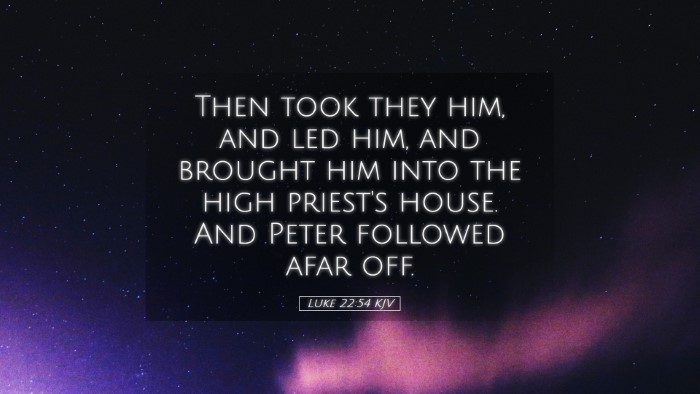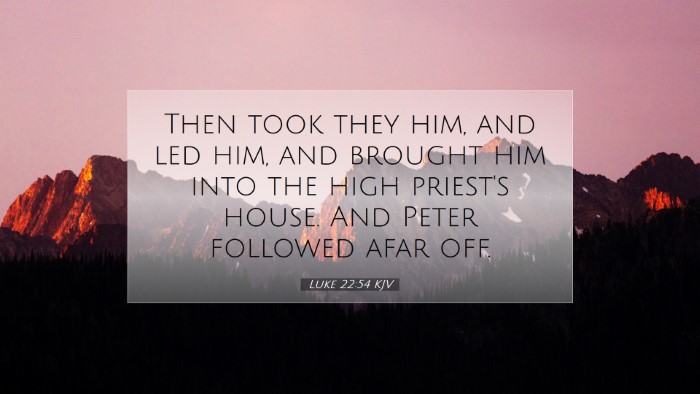Commentary on Luke 22:54
Luke 22:54 states: "Then took they him, and led him, and brought him into the high priest's house. And Peter followed afar off." This verse marks a pivotal moment in the narrative of Christ's trial and crucifixion, detailing Peter's conflicted position and fear as he follows Jesus at a distance.
Context and Significance
This passage occurs after Jesus’ betrayal by Judas and His arrest in the Garden of Gethsemane. The ensuing events highlight the tension between loyalty and fear, a profound theme that resonates throughout the Gospel narratives.
Insights from Matthew Henry
Matthew Henry offers a detailed analysis of Peter’s actions. He emphasizes the contrast between Peter's earlier bravado and his subsequent fear: "Peter had declared boldly that he would follow Jesus to prison and to death, yet here we see him following afar off, a sign of his wavering faith."
- Peter’s Distance: Henry suggests that Peter's distance represents not only physical separation but a spiritual retreat from faith. It signifies a loss of courage and commitment in the face of danger.
- The Role of Fear: Fear plays a critical role in Peter’s decision-making. Henry implies that fear can lead believers to compromise their commitments to Christ.
Insights from Albert Barnes
Albert Barnes expands on the implications of Peter’s actions in this verse. He notes that Peter's following at a distance symbolizes the struggles of many believers who attempt to maintain their faith while avoiding persecution:
- Symbolism of Distance: Barnes interprets Peter’s distance as a metaphor for how believers may find themselves in a similar position when confronted with trials. "Many wish to follow Jesus, but fear keeps them from closeness."
- Lessons on Discipleship: This situation illustrates that true discipleship often requires a willingness to endure hardship and to remain close to Jesus, even amid adversity.
Insights from Adam Clarke
Adam Clarke provides a more historical and contextual viewpoint, examining the implications of Peter's following Jesus during such perilous times. He articulates:
- Historical Context: Clarke points out the dangers of identifying with Jesus during His arrest, as followers risked arrest themselves. "Peter’s act of following conveyed a hope to witness the outcome—yet rendered him vulnerable."
- Spiritual Reflection: Clarke encourages reflection on the nature of faith when faced with opposition: "The true test of faith often comes under the shadow of fear."
Theological Implications
Drawing from the insights of these commentators, we can extract several theological implications:
- Human Weakness: Luke 22:54 reflects the frailty of human resolve. Believers are reminded of their propensity to falter under pressure.
- The Need for Support: As they navigate challenges, followers of Christ must seek support within their communities, fostering resilience and mutual encouragement.
- Grace in Failure: Peter’s story ultimately reminds us of the grace available following failure—a theme that will culminate in his restoration.
Practical Applications for Believers
For pastors, students, theologians, and scholars alike, this passage invites contemplation on how fear and distance can shape one's relationship with Christ:
- Identifying Distance: Prayerfully assess areas in life where fear has caused retreat from Jesus.
- Building Courage: Consider how to cultivate boldness in sharing faith, especially in challenging environments.
- Emphasizing Restoration: Embrace the assurance that even in moments of weakness, reconciliation with Christ is possible.
Conclusion
Luke 22:54 serves as a poignant reminder of the human condition in the face of trial. The reflections of Matthew Henry, Albert Barnes, and Adam Clarke provide a rich tapestry of insight, urging believers to examine the interplay between faith, fear, and the commitment to follow Christ. As we engage with this text, may it challenge and inspire deeper trust and loyalty to our Savior.


